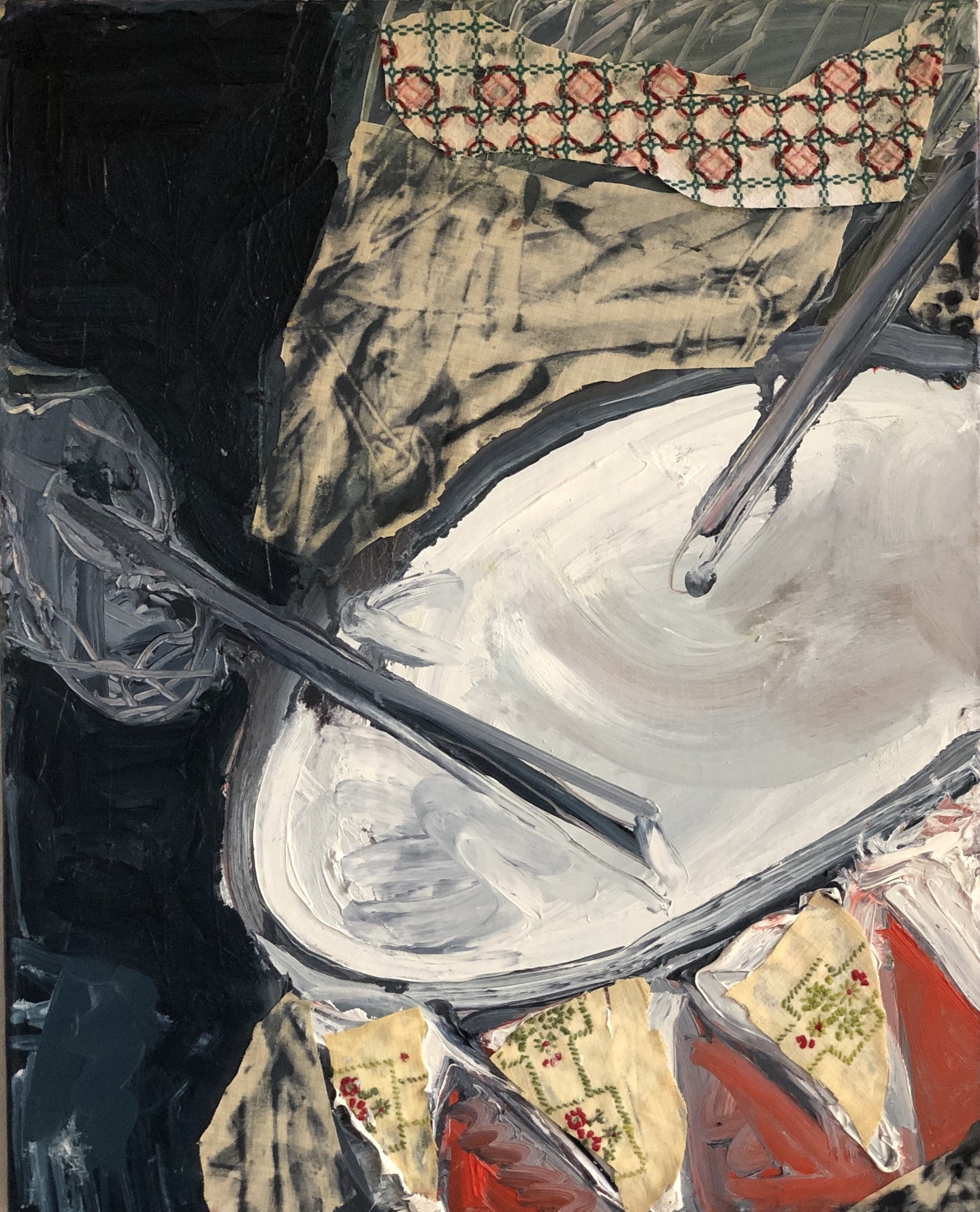De Trommelaar in de Stad - 2020
50 x 40 cm
Oil paint and embroidery on paper, on canvas
Origin of ‘De trommelaar in de Stad’ (‘The Drummer in the City’)
During the first lock down of the coronavirus pandemic, the borders between the Netherlands and Belgium were closed. Shortly after this historic border closure was lifted, I visited the studio of Jenetta de Konink in preparation for her exhibition "Drumroll and Moments of Seriousness ".
In this exhibition Jenetta shows recent works of art including the work ‘De Trommelaar in de Stad’ (‘The Drummer in the City’). It is part of the painting series ‘De Trommelaar’ (‘The Drummer’). This series was created in the spring of 2020 during the outbreak of the coronavirus pandemic. The terrible Covid-19 virus causes a state of mind of fear, doubt and uncertainty for the artist, and undoubtedly for everyone on this globe. Jenetta bridges this difficult time by channelling her feelings through the paintbrush.
Source of inspiration
By chance, the artist finds an inspiring image on social media. The screenshot from the film ‘Die Blechtrommel’ (after the book of the same name by Gunter Grass, 1959) immediately catches her attention. This picture shows Oskar Matzerath, a rather strange little boy with a drum. At the age of three, this hyper-intelligent child falls down the stairs and lands on his head. Because of the hypocrisy of the adult world in which he lives, Oskar wishes at that moment to stop growing. He wants to remain a child forever.
Since then, Oskar has been an unpredictable, almost dangerous little man and at the same time a small and frightened child. The world seems to revolve around him. He watches everything, experiences the most terrible horrors, but remains a conscious spectator in the story. In imminent danger he uses his main weapons: his drum and his voice. In this way, he partly unconsciously determines his own and other people's lives, sometimes with disastrous consequences.
The drum takes centre stage in this series
Jenetta de Konink reduces Oskar’s magical-surrealistic story to a series of paintings with a strong visual language. It is not the main character but the tin drum that takes centre stage in this series on canvas. The musical instrument has the capacity to increase tension and to accompany an event to its climax. For Jenetta, a drum is also a universal symbol for the announcement of danger, in this case the coronavirus. The artist experiences the drumroll as a wake-up call to her and the world that things cannot go on like this.
Image analysis
The painting ‘De trommelaar in de Stad’ (‘The Drummer in the City’) is a work of 50cm x 40cm. Jenetta works on brown wrapping paper that has been glued to a canvas before she starts painting. Paper is the ideal surface for her to apply her paint smoothly.
The direct and confident touch of oil paint on the artwork reveals a tremendous need to portray imminent danger. The predominantly grey-black background contrasts with the white skin of the drum, reinforcing the sense of impending doom. The black drumsticks pierce this turbulent, white surface and cause disturbance in the image. The alarming drumroll seems to be synchronised with the visibly smooth brush movements. As a result, the small work of art radiates enormous energy and dynamism.
Because of her affinity with textiles, Jenetta looks for worn-out pieces of fabric and carpet in second-hand shops. She uses them as a medium to paint more freely. Very intuitively, the artist presses small pieces of fabric into the pasty paint to create contrast, depth and framing. At the bottom of this painting, Jenetta has glued triangular embroidery patches between the blood-red colour areas of the drum. The viewer's eye is flung back and forth between these geometric planes and the elongated strip of red and green embroidery at the top of the painting. In combination with the oil paint, they create, on the one hand, an enormous layering. On the other hand, they create a certain playfulness and movement that lightens the seriousness of the painted theme.
